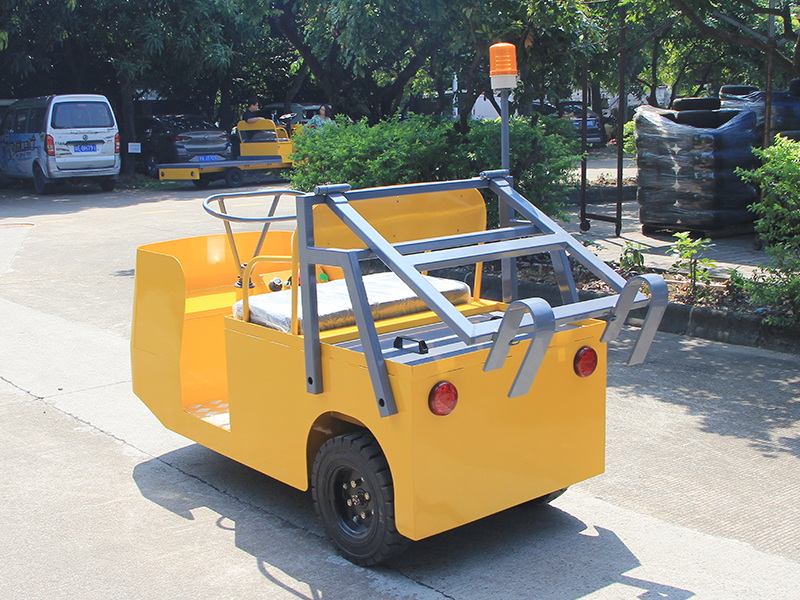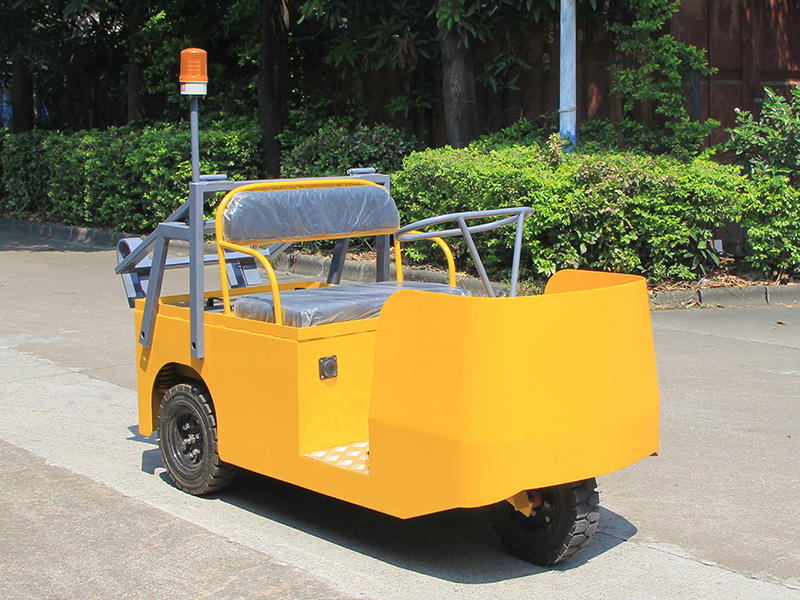Content Menu
● Introduction to Electric Towing Tractors in Airports
● Key Features of the Best Electric Towing Tractors
>> 1. High Towing Capacity
>> 2. Advanced Safety Systems
>> 3. Regenerative Braking
>> 4. Quiet Operation
>> 5. Familiar Design and Ease of Maintenance
● Leading Electric Towing Tractor Models for Airport Use
>> GYPOT E-Trac HeavyDuty 7000
>> Tiger Li-ion Tractor
>> GYPOT E-Trac 4000
● Environmental and Operational Benefits
>> Zero Emissions and Reduced Carbon Footprint
>> Energy Efficiency and Cost Savings
>> Enhanced Efficiency in Baggage and Cargo Handling
● Real-World Applications and Innovations
>> Autonomous Electric Tractors
>> Remote Control and Automatic Guided Vehicles (AGVs)
>> Quiet and Safe Operations in Crowded Terminals
>> Battery Technology Advancements
>> Integration with Airport Operations Management Systems
● Conclusion
● FAQ
>> 1. What is the typical towing capacity of electric towing tractors used in airports?
>> 2. How do electric towing tractors improve airport safety?
>> 3. Are electric towing tractors more cost-effective than diesel models?
>> 4. Can electric towing tractors operate autonomously?
>> 5. What environmental benefits do electric towing tractors offer?
Electric towing tractors have become a vital part of modern airport ground support operations. With increasing emphasis on sustainability, efficiency, and safety, airports worldwide are transitioning from diesel-powered tugs to electric alternatives. This article explores the best electric towing tractors available for airport use, highlighting their features, benefits, and real-world applications.

Introduction to Electric Towing Tractors in Airports
Electric towing tractors, also known as electric aircraft tugs or pushback tractors, are specialized vehicles designed to tow aircraft and cargo equipment on airport ramps. Unlike traditional diesel tugs, electric towing tractors operate with zero emissions, reduced noise, and enhanced operational efficiency. Airports provide an ideal environment for electric vehicles (EVs) due to controlled spaces and proximity to charging infrastructure.
The growing global focus on reducing carbon emissions in aviation has put ground support equipment (GSE) under scrutiny. While aircraft manufacturers work on greener planes, airports are addressing their own carbon footprints by electrifying their ground fleets. Electric towing tractors are at the forefront of this transformation, offering a cleaner, quieter, and more cost-effective solution for moving aircraft and equipment.
Key Features of the Best Electric Towing Tractors
1. High Towing Capacity
Modern electric towing tractors can tow between 40 to 70 tons, making them suitable for a wide range of aircraft, from small regional jets to large wide-body planes. For example, the GYPOT E-Trac HeavyDuty 7000 offers towing capacities up to 70 tons, ideal for heavy cargo and large aircraft operations. This capacity ensures that electric tugs can replace diesel models without compromising on performance.
The ability to handle heavy loads is critical because airports operate a diverse fleet of aircraft, including cargo planes, passenger jets, and private aircraft. Electric tractors are engineered with high-torque electric motors that deliver instant power and smooth acceleration, even under full load.
2. Advanced Safety Systems
Safety is paramount in airport operations. Leading electric tugs are equipped with obstacle detection, collision avoidance systems (such as LiDAR and ultrasonic sensors), and emergency stop functions. These features reduce accident risks and enhance ground crew safety.
Some models include driver assistance technologies such as 360-degree cameras, proximity alarms, and automatic speed reduction in congested areas. These systems help operators maneuver safely around aircraft, ground personnel, and other vehicles on busy ramps.
3. Regenerative Braking
Electric tractors often feature regenerative braking systems that convert kinetic energy back into battery power, extending operational time and reducing the need for frequent recharging. This is particularly beneficial in busy airports like Frankfurt, where reliability is critical.
Regenerative braking not only improves energy efficiency but also reduces wear on mechanical brake components, lowering maintenance costs and downtime. This feature is especially useful in airport environments with frequent stop-and-go movements.
4. Quiet Operation
Electric towing tractors operate at noise levels around 50-55 decibels, significantly quieter than diesel alternatives which can reach 80-85 decibels. This noise reduction improves working conditions for ground personnel and helps airports comply with noise regulations.
Reduced noise pollution is particularly important during night operations or in airports located near residential areas. Quieter tugs contribute to a better working environment and reduce stress for ground crews who spend long hours on the ramp.
5. Familiar Design and Ease of Maintenance
Some models, such as Tiger's Li-ion tractors, maintain the familiar chassis and parts common to traditional tugs, simplifying operator training and maintenance. This design philosophy helps airports transition smoothly from diesel to electric without extensive retraining or infrastructure overhaul.
Electric tractors generally have fewer moving parts than diesel vehicles, which translates to lower maintenance requirements and higher uptime. Battery management systems monitor health and performance to optimize charging cycles and extend battery life.
Leading Electric Towing Tractor Models for Airport Use
| Model | Towing Capacity | Battery Type | Special Features | Notable Airports Using It |
| GYPOT E-Trac HeavyDuty 7000 | Up to 70 tons | Lithium-ion / NiMH | Dual-drive system, regenerative braking | Los Angeles International |
| Tiger Li-ion Tractor | Up to 60,000 lbs | Lithium-ion | Steel body-on-frame, common parts for easy repair | Various global airports |
| GYPOT E-Trac 4000 | Up to 40 tons | Lithium-ion | High torque converter, smooth hauling | Dubai International |
GYPOT E-Trac HeavyDuty 7000
The GYPOT E-Trac HeavyDuty 7000 is designed for the heaviest towing demands. Its dual-drive system provides excellent traction on wet or uneven surfaces, and the regenerative braking system helps extend battery life during long shifts. This model is popular at large international airports with heavy cargo traffic.
Tiger Li-ion Tractor
Tiger's Li-ion tractor combines proven mechanical design with modern electric powertrains. Its steel body-on-frame construction offers durability, while the use of common parts reduces spare parts inventory and maintenance complexity. This model is widely adopted for its reliability and ease of integration.
GYPOT E-Trac 4000
The E-Trac 4000 is a versatile mid-range electric tug suitable for towing smaller aircraft and ground equipment. It features a high torque converter for smooth hauling and is equipped with advanced safety features. Dubai International Airport has integrated these tractors into their fleet to reduce emissions and noise.

Environmental and Operational Benefits
Zero Emissions and Reduced Carbon Footprint
Electric towing tractors produce no localized emissions, helping airports reduce their carbon footprint significantly. Replacing one diesel tug with an electric equivalent can cut greenhouse gas emissions by about 50 metric tons of CO₂ annually, comparable to removing 10 passenger vehicles from the road.
This reduction supports airport sustainability goals and helps meet increasingly stringent environmental regulations. Many airports are now incorporating electric GSE into their carbon-neutral strategies, contributing to the broader aviation industry's environmental commitments.
Energy Efficiency and Cost Savings
Electric tractors convert over 85% of their energy into propulsion, far exceeding the 30% efficiency typical of diesel engines. Airports like Heathrow and Changi have reported up to 25% reductions in energy costs after switching to electric ground support equipment.
Lower energy consumption combined with reduced maintenance requirements leads to significant total cost of ownership (TCO) savings. Electric tractors also benefit from lower fuel price volatility, as electricity costs are generally more stable than diesel fuel prices.
Enhanced Efficiency in Baggage and Cargo Handling
Electric tugs provide optimized torque delivery and zero-delay acceleration, enabling 15-20% faster baggage transfer times compared to diesel tugs. This efficiency is crucial in high-traffic airports to minimize delays and improve turnaround times.
The precise control offered by electric motors allows operators to maneuver aircraft and equipment with greater accuracy, reducing the risk of damage and improving overall operational flow.
Real-World Applications and Innovations
Autonomous Electric Tractors
Some airports, such as Hong Kong International Airport, have pioneered the use of autonomous electric tractors capable of operating end-to-end across cargo terminals and ramp operations. These vehicles reduce human error and improve operational consistency.
Autonomous electric tractors use a combination of GPS, LiDAR, and computer vision to navigate complex airport environments safely. They can be programmed to follow optimized routes, reducing congestion and improving throughput.
Remote Control and Automatic Guided Vehicles (AGVs)
Manufacturers are integrating remote control and AGV technologies into electric towing tractors, allowing programmed routes and speeds for moving aircraft parts or baggage autonomously within airport zones.
Remote control operation enables ground personnel to maneuver tugs from a safe distance in tight or hazardous areas. AGVs can operate continuously with minimal supervision, improving efficiency in repetitive tasks such as baggage cart movement.
Quiet and Safe Operations in Crowded Terminals
Electric tugs' quiet operation and precise control systems make them ideal for maneuvering in crowded terminal environments where space is limited and safety is critical. Their low noise footprint reduces distractions and stress for ground crews.
In addition, electric tractors emit no exhaust fumes, improving air quality in enclosed or semi-enclosed ramp areas, which benefits personnel health and complies with occupational safety standards.
Battery Technology Advancements
Recent advances in lithium-ion battery technology have significantly improved the range, charging speed, and lifespan of electric towing tractors. Fast-charging capabilities allow some models to recharge to 80% capacity in under an hour, minimizing downtime.
Battery management systems (BMS) monitor temperature, voltage, and current to ensure optimal performance and safety. Some airports have implemented centralized charging stations with smart scheduling to maximize tractor availability.
Integration with Airport Operations Management Systems
Modern electric towing tractors can be integrated with airport operations management software, allowing real-time tracking, usage analytics, and predictive maintenance alerts. This connectivity helps airports optimize fleet utilization and reduce unexpected breakdowns.
Data collected from electric tugs can also support environmental reporting and compliance documentation, providing airports with transparent metrics on their sustainability efforts.
Conclusion
Electric towing tractors represent the future of airport ground support operations by combining powerful towing capacity, advanced safety features, environmental sustainability, and operational efficiency. Leading models like the GYPOT E-Trac series and Tiger Li-ion tractors are already transforming airports worldwide, reducing emissions, noise, and costs while improving safety and throughput. As battery technology and automation continue to advance, electric towing tractors will become even more integral to modern airport logistics, supporting the aviation industry's transition to a greener, more efficient future.

FAQ
1. What is the typical towing capacity of electric towing tractors used in airports?
Electric towing tractors typically have towing capacities ranging from 40 to 70 tons, suitable for towing various aircraft sizes and cargo loads.
2. How do electric towing tractors improve airport safety?
They include advanced safety features such as obstacle detection, collision avoidance, emergency stop functions, and access controls to prevent unauthorized use.
3. Are electric towing tractors more cost-effective than diesel models?
Yes, electric tractors have lower maintenance costs (about 25% less), higher energy efficiency, and reduce fuel expenses, leading to significant cost savings over time.
4. Can electric towing tractors operate autonomously?
Yes, some airports have implemented autonomous electric tractors and Automatic Guided Vehicles (AGVs) that follow programmed routes to improve efficiency and reduce human error.
5. What environmental benefits do electric towing tractors offer?
They produce zero emissions, reduce noise pollution, and help airports meet carbon reduction goals by significantly lowering greenhouse gas emissions compared to diesel tugs.










































